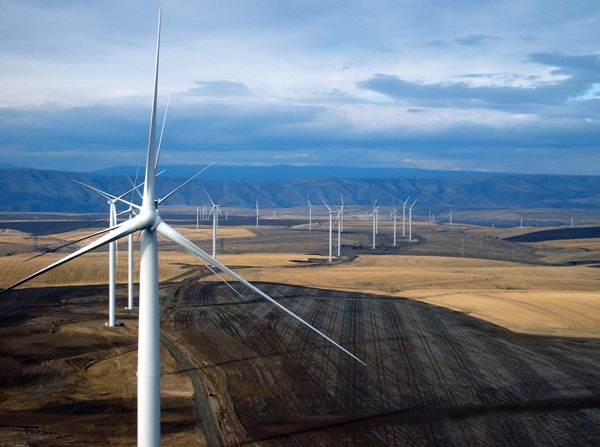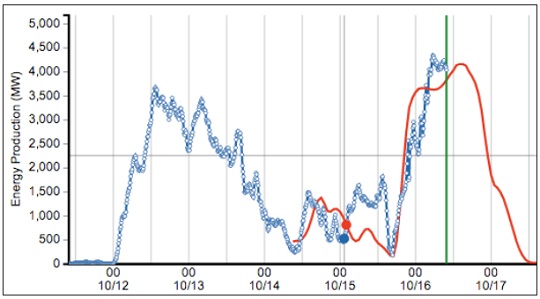For apparently the first time in the Pacific Northwest, wind power on Tuesday beat hydroelectricity, the energy source that industrialized and still dominates the region.
The private renewable energy risk analyst 3Tier spotted the milestone event in data from the Bonneville Power Administration, noting that at 2:50 a.m. on Tuesday morning, as a cold front roared through the region, wind on the BPA system was producing 3,169 megawatts of electricity, while hydro was at 3,165. Wind maintained its edge on hydro until around sunrise, was supplanted for most of the morning, but then out-produced hydro again from 11 a.m. until 5:50 p.m.

At its peak on Tuesday morning, at 5:35 a.m., wind was sending 4,361 megawatts of power to BPA. The agency, which controls around three-quarters of the Pacific Northwest grid, reported its total load at the time was 5,101 megawatts.
3Tier pointed out that this meant that wind was meeting 85 percent of the region’s demand at the time, although it should be noted that BPA is a net exporter of energy, and that at 5:35 a.m. it was actually seeing generation of more than 11,000 MW between wind, hydro and thermal.
Still, it was a lot of wind power. It was just this past March that wind power exceeded 4,000 MW for the first time on the BPA system. The agency said then that it expected to have 5,000 MW of wind capacity online by 2013.

Early fall is a better time for wind to make big contributions to BPA. There’s generally less water behind the system’s 31 dams then, whereas in the spring and early summer in recent years runoff into the Columbia and Snake rivers and their tributaries has left BPA with more power than it can handle. The result has been conflict with wind developers over BPA’s policies in dealing with too much of a good thing.
In fact, last December, federal regulators said BPA acted unfairly in shutting off wind power in spring 2011 when an extra-big snowpack began to melt.
BPA’s unilateral curtailment of wind was opposed by wind generators, led by Portland, Ore.-based Iberdrola Renewables, many of whom lost federal production tax credits and state renewable energy certificates when their turbines were shut down and who worried that BPA’s policy could set a precedent that would stifle future support for the industry in the region. BPA later proposed new measures — including splitting the cost for lost revenue — to mollify the wind producers when their power loses out to hydro. In 2012, wind producers were forced to power down four times, giving up just over 20,000 MWh of power production.

Wind power’s variability can be a challenge for grid operators. This week, by Wednesday evening, a day after wind beat hydro, production from the thousands of turbines in Oregon, Washington and Idaho was at times in the single-digit megawatts, a tiny fraction of wind’s earlier performance. And yet as 3Tier noted in its release — and the chart above shows — the big swings are actually fairly predictable.